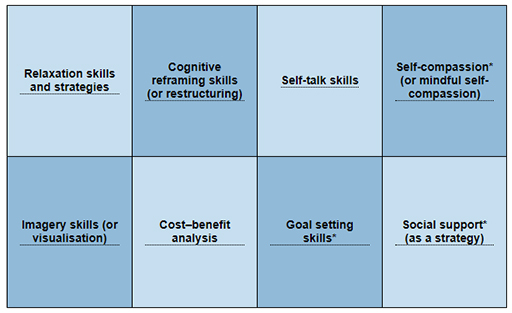1 The range of strategies
Each reference source you consult is likely to recommend slightly different burnout reduction strategies. Each source may use different names to describe them (e.g. visualisation or imagery – largely the same thing) or different techniques (e.g. progressive muscular relaxation or relaxation breathing – again, the same idea).
In order to appreciate the range of psychological tools available to prevent burnout, examine Figure 2 (adapted from University of Michigan, 2018). Click on ‘View interactive version’ at the bottom of the figure and hover over the eight skills and strategies to read an overview of each. It gives an overview of eight skills and strategies. You will be guided towards further information on each skill or strategy later.
Much information about these strategies is available online but there is no guarantee that the resources are reliable. The University of Michigan (shown in Figure 3) is a reliable source because it is an organisation that highly values sport but also has research, academic and medical departments relating to sport and psychology.
In the activity below you will have the opportunity to find out more about these sport psychology strategies. Note, however, that the information from this activity will not be quizzed.
Activity 1 Find out more about sport psychology strategies
Session 8 focuses on three of the strategies from Figure 2 – self-compassion, goal setting and social support. Each of these has a recognisable evidence-based impact on burnout. This activity is an opportunity to learn more about the other five strategies, plus some additional approaches to supporting mental well-being in sport, from the University of Michigan.
If you want to find out more about:
- cognitive reframing skills (or restructuring)
- self-talk skills
- imagery skills (or visualisation)
- cost–benefit analysis
- breathing and muscular relaxation skills
visit the Athletes Connected Skills and Strategies page at the University of Michigan [Tip: hold Ctrl and click a link to open it in a new tab. (Hide tip)] .
Discussion
In this exploratory task, you can see that these five strategies can all also contribute in some way to reducing burnout.
You will now look in more detail at the first of the three intervention strategies that are the focus of this session – the relatively new strategy of self-compassion.


